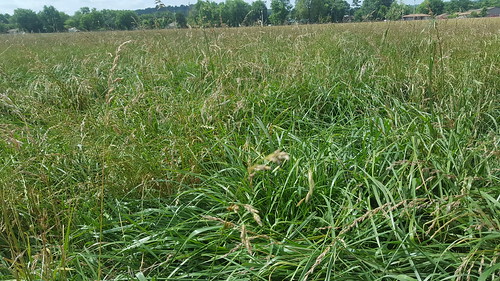Tips for keeping your perennial cool season grasses productive during the summer and beyond
By the U of A System Division of Agriculture
June 30, 2017
Fast Facts:
- Novel-endophyte fescues (NE+) are as resilient as KY-31, if managed properly
- NE+ fescues can be stockpiled during vigorous spring & fall growth
(543 words)
(Download this story in MS Word here.)
LITTLE ROCK – As anyone with a hand in the U.S. cattle business will tell you, fescue grass is one of the primary pillars of the industry, with approximately 2 million acres of the cool season grass grown by cattle producers in Arkansas alone.
The older versions of KY-31, a variety of fescue introduced to Arkansas in the first half of the 20th century for its tolerance to heat stress — and, unfortunately, commonly associated with fescue toxicosis — often make it through summers unscathed. But for farmers who have invested in newer, non-toxic novel-endophyte types (NE+), a bit more management is involved, said Dirk Philipp, Associate Professor of Forages for the University of Arkansas System Division of Agriculture.
“Fescue, in general, is a robust forage and will shut down growth when summer temperatures get really hot and rainfall is scarce,” Philipp said. “The time of slowed summer growth is hard to predict, and mostly depends on the length of a dry spell.”
Philipp said fescue has a “growth curve,” with much growth occurring in spring, and very little in the summer. The grass should be managed according to the season, he said, rather than taking a cookie-cutter approach to pastures.
He noted that the newer novel-endophyte grasses are nearly as resilient and long-lasting as the old toxic KY-31 grasses.
“We have had them on our research farm for several years now, and never run into problems from heavily stocking them,” he said. “The key is to understand what makes grasses grow after a hay cut or a grazing, which is the photosynthetically active leave tissue — the green leaves. It’s not like in legumes, where regrowth is initiated from root reserves.”
This means that after each grazing, there needs to be leave area left on the plant for good regrowth, Philippp said. This becomes more crucial as the summer months approach, and as the environmental stress on fescue pastures increases. With diminished leave area, root growth and renewal is diminished as well.
Philipp suggests a few general rules for managing these grasses:
- It is hard to predict how quickly roots will die back, but a small root structure will not support vigorous regrowth if needed.
- As a general rule, keep at least 4 inches of leave blades on fescue plants after a grazing event, and let plants regrow to at last 8-12 inches before moving cattle back into a paddock.
- Even NE+ fescue is resilient enough to be stocked early in the season or late fall and winter; however, during summer rotational stocking is in order to catch the moment when fescue has to be rested,
- Again, leave at least 4 inches of leaf on the plants to ensure regrowth once rainfall, albeit sparse, may occur during July and August,
To diversify forage bases with long-term growth and sustainability in mind, Philipp offers additional tips:
- Have a backup for whenever fescue growth slows in summer. Complement fescue with summer annual forages such as sorghum-sudangrass.
- To take pressure off perennial cool season grasses, set some acres aside for establishing summer annuals
- Fescue can be stockpiled for late fall/winter use once other forages have gone dormant.
To learn about forage grasses, contact your local Cooperative Extension Service agent or visit www.uaex.uada.edu.
About the Division of Agriculture
The University of Arkansas System Division of Agriculture’s mission is to strengthen agriculture, communities, and families by connecting trusted research to the adoption of best practices. Through the Agricultural Experiment Station and the Cooperative Extension Service, the Division of Agriculture conducts research and extension work within the nation’s historic land grant education system.
Pursuant to 7 CFR § 15.3, the University of Arkansas System Division of Agriculture offers all its Extension and Research programs and services (including employment) without regard to race, color, sex, national origin, religion, age, disability, marital or veteran status, genetic information, sexual preference, pregnancy or any other legally protected status, and is an equal opportunity institution.
# # #
Media Contact: Mary Hightower
Dir. of Communication Services
U of A Division of Agriculture
Cooperative Extension Service
(501) 671-2126
mhightower@uada.edu
Related Links
